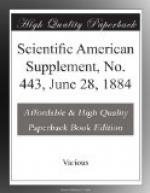Magnesium in particular, also zinc and cadmium, were greatly depressed in electromotive force in electrolytes by elevation of temperature. Reversals of position of two metals of a voltaic couple in the tension series by rise of temperature were chiefly due to one of the two metals increasing in electromotive force faster than the other, and in many cases to one metal increasing and the other decreasing in electromotive force, but only in a few cases was it a result of simultaneous but unequal diminution of potential of the two metals. With eighteen different voltaic couples, by rise of temperature from 60 deg. to 160 deg. F., the electromotive force in twelve cases was increased, and in six decreased, and the average proportions of increase for the eighteen instances was 0.10 volt for the 100 deg. F. of elevation.
A great difference in chemical composition of the liquid was attended by a considerable change in the order of the volta-tension series, and the differences of such order in two similar liquids, such as solutions of hydric chloride and potassic chloride, were much greater than those produced in either of those liquids by a difference of 100 deg. F. of temperature. Difference of strength of solution, like difference of composition or of temperature, altered the order of such series with nearly every liquid; and the amount of such alteration by an increase of four or five times in the strength of the liquid was rather less than that caused by a difference of 100 deg. F. of temperature. While also a variation of strength of liquid caused only a moderate amount of change of order in the volta-tension series, it produced more than three times that amount of change in the thermo-electric tension series. The usual effect of increasing the strength of the liquid upon the volta-electromotive force was to considerably increase it, but its effect upon the thermo-electro-motive force was to largely decrease it. The degree of potential of a metal and liquid thermo-couple was not always exactly the same at the same temperature during a rise as during a fall of temperature; this is analogous to the variations of melting and solidifying points of bodies under such conditions, and also to that of supersaturation of a liquid by a salt, and is probably due to some hinderance to change of molecular movement.
The rate of ordinary chemical corrosion of each metal varied in every different liquid; in each solution also it differed with every different metal. The most chemically positive metals were usually the most quickly corroded, and the corrosion of each metal was usually the fastest with the most acid solutions. The rate of corrosion at any given temperature was dependent both upon the nature of the metal and upon that of the liquid, and was limited by the most feebly active of the two, usually the electrolyte. The order of rate of corrosion of metals also differed in every different liquid. The more dissimilar the chemical characters of two liquids, the more diverse usually was the order of rapidity of corrosion of a series of metals in them. The order of rate of simple corrosion in any of the liquids examined differed from that of chemico-electric and still more from that of thermo-electric tension. Corrosion is not the cause of thermo-electric action of metals in liquids.




